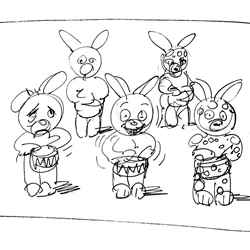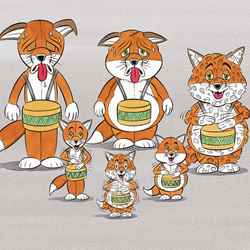Tambourines, foxes, and zeolite crystals
Under the covers
Professor Javier Pérez-Ramírez and his group at ETH Zürich design catalysts for sustainable technologies. Sharon Mitchell, the first author on a new paper published in Catalysis Science & Technology, discusses how they are optimising zeolite crystals for their use as catalysts, whilst Amalia Gallardo, who created the image alongside fellow designer Marcel Reich, explains the concept.
Sharon: Every design process involves the optimization of different parameters. For example, if you want to develop a more efficient hybrid car, you could consider using a high-performance battery, reducing the weight, adopting a more aerodynamic shape, and so on. In the same way, we can engineer the different properties of a catalyst to make it more durable.
Zeolites are a special type of material with regular pores of dimensions similar to those of simple molecules like water or carbon dioxide, and are often used as catalysts. It is said that zeolite catalysts are used at some point in the production of almost every synthetic chemical. Improving their durability by tailoring their properties can therefore lead to significant improvements in the efficiency of these processes.
When zeolites are used as catalysts, bulky molecules can sometimes get trapped inside them and block their pores, by a mechanism known as coking, so that they can no longer be utilized. Our article quantifies the effect of varying the size, shape, amount of defects, and the introduction of additional porosity in zeolite crystals on their lifetime as catalysts in a given chemical transformation. This is studied using a reaction which converts a growing oil refinery by-product into important building blocks for the production of plastics.
From the art desk
Amalia: The cover was inspired by the concept of durability. This reminded us of an advertisement from our childhood, in which a group of toy bunnies powered by different batteries played drums with different intensities. As time passed only one bunny remained active.
The next step was to translate this concept to illustrate our ideas. To do this, we designed a family of foxes with distinct features (tall, short, spotty, torn) to represent the different crystal properties studied. The foxes play drums with different tempos corresponding to the relative catalytic lifetimes.
The artwork is a colour handmade illustration that took form by improving a series of sketches. The first sketch roughly illustrated the concept and the character was subsequently refined to reflect the different crystal properties.
Read the article: Engineering of ZSM-5 zeolite crystals for enhanced lifetime in the production of light olefins via 2-methyl-2-butene cracking
The image appeared on the inside front cover of Catalysis Science & Technology, 2017, Issue 1.
Press office
- Tel:
- +44 (0) 20 7440 3351
- Email:
- Send us an email



